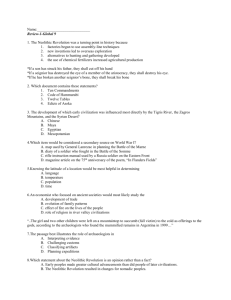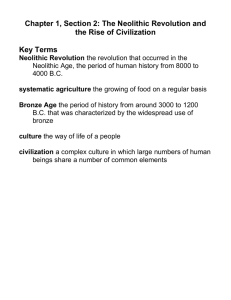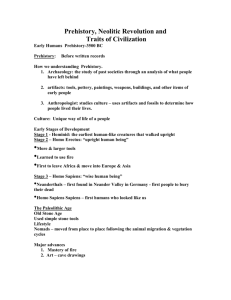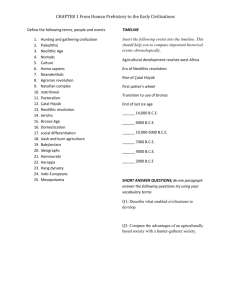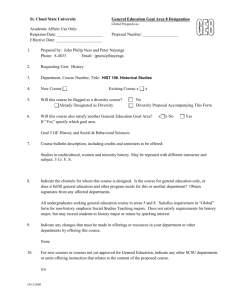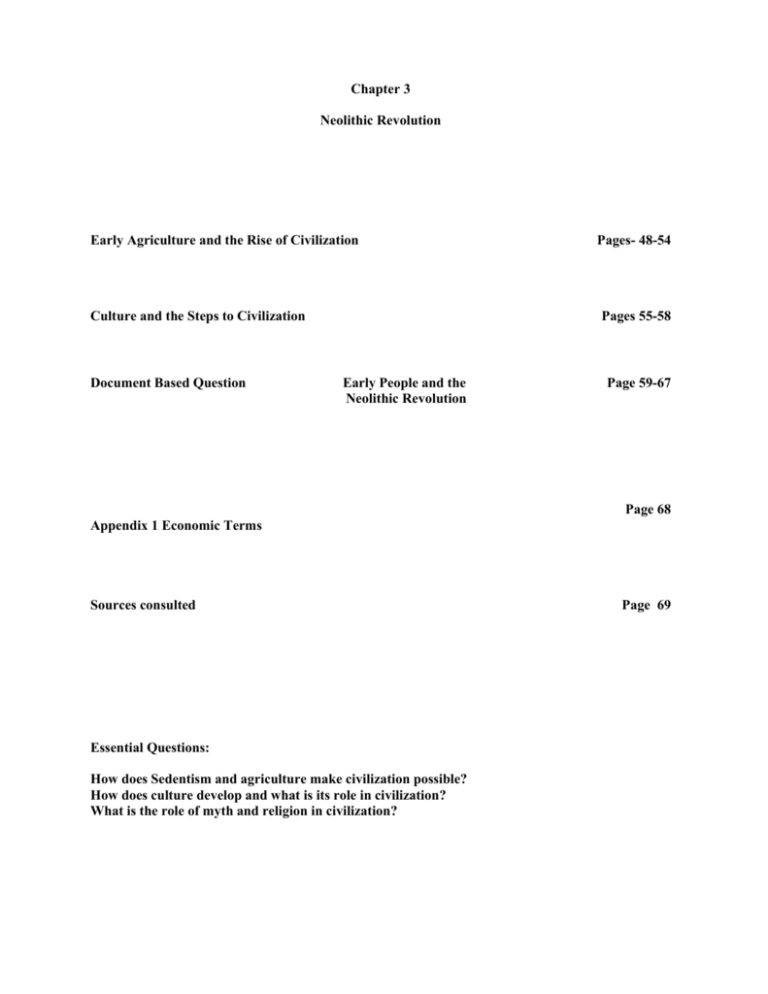
Chapter 3
Neolithic Revolution
Early Agriculture and the Rise of Civilization
Culture and the Steps to Civilization
Document Based Question
Pages- 48-54
Pages 55-58
Early People and the
Neolithic Revolution
Page 59-67
Page 68
Appendix 1 Economic Terms
Sources consulted
Essential Questions:
How does Sedentism and agriculture make civilization possible?
How does culture develop and what is its role in civilization?
What is the role of myth and religion in civilization?
Page 69
The Neolithic and Agriculture
The Neolithic Revolution (also known as the Agricultural Revolution) is the tem
used to describe the transition from nomadic hunting and gathering societies to
settled agrarian societies. Taken as a whole, from start to finish, the transition
certainly was a revolution in the entirety of changes it brought in the way people
lived. Considered over the entire 250,000 year span of human existence, the
several thousand years it took was relatively sudden. The changes in any given
lifetime were imperceptible. Cumulatively, over time, they were enormous. The
transition took place where both the Paleolithic hunting and gathering and
Neolithic gardening ways of life could co-exist simultaneously.
Younger
Dryas
The great ocean conveyor belt is a
vital component of the global ocean
nutrient and carbon dioxide cycles.
Warm surface waters are depleted
of nutrients and carbon dioxide, but
they are enriched again as they
travel through the conveyor belt as
deep or bottom layers. The base of
the world’s food chain depends on
the cool, nutrient-rich waters that support the growth of algae and seaweed.
Global climate change could disrupt the global conveyer belt, causing potentially
drastic temperature changes in Europe and even worldwide.
Fourteen thousand years ago, the Ice Age was coming to an end and temperatures
were warming very quickly. Food became available in relative abundance for the
first time in thousands of years. Instead of having to travel long distances to find
food, some groups were able to live in the same place all year round. People
started to build permanent dwellings. By 10,000 BC, the end of the Younger
Dryas period, they were discovering that certain animals, such as goats, sheep,
cattle and pigs, had temperaments and dispositions that made them easy to
manage within close proximity to their dwellings. They selected and cultivated
certain grains, such as oats, wheat and barley, which provided nourishment to
larger groups of people and would last for long periods without spoiling.
Horticulture
and
Gardening
From weeding around a plant, or perhaps watering it in a dry spell, it is a small
step to collecting its seeds and planting them in a protected spot where they will
have a better than average chance of growing. From penning in animals, to kill
them when needed, it is a small step to keeping them until their offspring are
born. In any one place the process will be gradual. Cultivated crops or
domesticated animals form at first only a small part of a community's diet, most
of it coming still from hunting and gathering. Settling down in a community does
not lead to gardening-- gardening leads to settling down in communities. The
transition to horticulture resulted in the settlement of villages around the garden
plots with hunting expeditions reduced to limited forays from the settled home
base. Horticultural villages usually moved every few years when the garden soil
was exhausted and fresh new plots were cleared. Typically, it was the women
who knew where and when to gather the local domesticates.
48
Repeated harvestings engaged collector and collected in a positive feedbacknatural selection process that changed the domesticate species genetically to
favor its selection and reproduction. Over time, passive gathering became active
planting, tending and harvesting. A garden, being a more or less permanent
location, forces those who tend and harvest the garden to remain in the same
place for longer periods of time.
Role of
Women
Where and
Why?
The central role of women in horticultural societies had political and
sociological consequences. It was the women who owned and managed their
garden plots and passed them on to the next generation. It was the women who
decided when their soil was depleted and where the village should move. One
of the interesting aspects of horticultural societies is that it is often women who
exercise political power and authority in their society. Horticulture was the
critical intermediate step between hunting and gathering and fully developed
agriculture. A later shift from small plot horticulture to large field crop
agriculture occurred with the introduction of domestic animal power as well as
metal working technologies.
It was at this stage that agriculturalists could afford to abandon their former
hunting ranges altogether and to settle permanently in the prime agricultural
lands of river valleys with their rich alluvial soils. It was also at this stage, with
its heavier field work and animal husbandry, that men took control of the land
and animals and resumed their dominant position in society over women.
The importance of the slow technological and economic development that led
many societies from hunting and gathering economy to plant cultivation and
animal husbandry is indeed enormous. In transforming H. sapiens from a
mere consumer of natural goods into a producer, the development of
agriculture drastically changed the role of humanity within its environment,
and thus the very nature of humankind. Moreover, it permitted a vast
transformation of human life and activity, involving both a demographic
increase and the rise of more complex human settlements and communities.
Agriculture required an increasingly greater specialization differentiation and
stratification within societies, and made possible, and indeed necessary, the
"urban revolution" that was to follow within three or four millennia in
Mesopotamia and Egypt.
Irrigation
49
One reason that civilization first appeared in the Middle East was because
agriculture had taken hold in this region. The river valleys provided people
with fertile soil due to their floods. These floods, combined with the newfound knowledge of farming and animal domestication, allowed for a stable
food supply and so the Neolithic people settled down around these rivers.
But localized agriculture did not consistently yield the kind of surplus that
would allow specializations among the population, and therefore it could not
generate civilization. Even the formation of small regional centers, such as
Jericho or Catal Huyuk (see map page 37), did not assure a rapid pace of
change. Their economic range remained localized, with little trade or
specialization. It was important that more and more regions in the Middle East
were pulled into the orbit of agriculture as the Neolithic revolution gained
ground.
The needs of irrigation, plus protection from marauders, help explain why most
early agricultural peoples settled in village communities, rather than isolated
farms. Some big rivers encouraged elaborate irrigation projects that could
channel water, virtually assured quantities to vast stretches of land. To create
larger irrigation projects along major rivers such as Tigris-Euphrates or the
Nile, large gangs of laborers had to be assembled. Further, regulations had to
assure that users along the river and in the villages near the river's source would
have equal access to the water supply. This implied an increase in the scale of
political and economic organization. A key link between the advantages of
irrigation and the gradual emergence of civilization was that irrigated land
produced surpluses with greater certainty and required new kinds of
organization.
Property
Settled agriculture, as opposed to slash-and-burn varieties, usually implied some
forms of property so that land could be identified as belonging to a family, a
village, or a landlord. Only with property was there incentive to introduce
improvements, such as wells or irrigation measures that could be monopolized
by those who created them or left to their heirs. But property meant the need for
new kinds of laws and enforcement mechanisms, which in turn implied more
extensive government. Here agriculture could create some possibilities for trade
and could spur innovation
Security
Disease
All this wealth, prosperity, and stability had a downside. There were lots of
people around who greatly coveted it and would stop at nothing to get hold of it.
New security measures were required to keep unwanted people away from other
peoples' possessions. Barriers and walls were constructed, leading in time to
forts and citadels. Yet another group of specialists, soldiers, emerged, either to
defend the property of the rich, or to attack others in order to achieve greater
enrichment. Rules governing the rights of property ownership had to be devised
and enforced, leading to the legal system.
The new sedentary lifestyle brought with it an unprecedented and enduring
threat. For the first time in history, large groups of humans, animals, waste
material, and rubbish were concentrated together in the same households.
Hunter-gatherers could always up and leave when conditions in any one place
became too putrid. Sedentary farmers did not have such luxuries available to
them. This close proximity conferred advantages to select organisms that were
quickly able to jump species, infecting the human population in large numbers
for the very first time. Examples included smallpox, tuberculosis and measles,
influenza and malaria. Although medicine has played a major role in quelling
many diseases in modern society, many of them continue to kill millions of
people each year.
Economics
Contemporary industrial societies have organized markets for land, labor, and
money, and virtually everything is a commodity. People buy and sell goods and
services using money. This form of economy, known as capitalism, disconnects
the value of goods and services from the goods and services themselves and the
people who produce or provide them. Thus, the exchange of goods and services
for currency is not particularly important for creating social bonds.
50
In industrialized and commerce-based societies, people also exchange securities
(such as the stocks of corporations), which have value based on their representation
of ownership.
This material culture includes products of
human manufacture, such as technology. This
system is commonly known as an economy.
Anthropologists look at several aspects of
people’s material culture. These include the
methods by which people obtain or produce
food, known as a pattern of subsistence; the
ways in which people exchange goods and
services; the kinds of technologies and other objects people make and use;
the effects of people’s economy on the natural environment.
Did the
Agrarian
revolution
Decrease
the work
load?
Source Reading One
The Origins Of Civilizations
The Agrarian Revolution And The Birth Of Civilization
Various Authors
Edited By: R. A. Guisepi
There was nothing natural or inevitable about the development of agriculture.
Because cultivation of plants requires more labor than hunting and gathering, we can
assume that Stone Age humans gave up their former ways of life reluctantly and
slowly. In fact, peoples such as the Bushmen of Southwest Africa still follow them
today. But between about 8000 and 3500 B.C., increasing numbers of humans
shifted to dependence on cultivated crops and domesticated animals for their
subsistence. By about 7000 B.C., their tools and skills had advanced sufficiently for
cultivating peoples to support towns with over one thousand people, such as Jericho
in the valley of the Jordan River and Catal Huyuk in present-day Turkey. By 3500
B.C., agricultural peoples in the Middle East could support sufficient numbers of
non-cultivating specialists to give rise to the first civilizations. As this pattern spread
to or developed independently in other centers across the globe, the character of
most human lives and the history of the species as a whole were fundamentally
transformed.
51
Causes Of The
Agrarian
Transformation
Domestication
Of Plants And
Animals
Because there are no written records of the transition period between 8000 and
5000 B.C. when many animals were first domesticated and plants were
cultivated on a regular basis, we cannot be certain why and how some peoples
adopted these new ways of producing food and other necessities of life.
Climatic changes associated with the retreat of the glaciers at the end of the
last Ice Age (about 12,000 B.C.), may have played an important role. These
climatic shifts prompted the migration of many big game animals to new
pasturelands in northern areas. They also left a dwindling supply of game for
human hunters in areas such as the Middle East, where agriculture first arose
and many animals were first domesticated. Climatic shifts also led to changes
in the distribution and growing patterns of wild grains and other crops on
which hunters and gatherers depended. In addition, it is likely that the shift to
sedentary farming was prompted in part by an increase in human populations
in certain areas. It is possible that the population growth was caused by
changes in the climate and plant and animal life, forcing hunting bands to
move into the territories where these shifts had been minimal. It is also
possible that population growth occurred within these unaffected regions,
because the hunting-and-gathering pattern reached higher levels of
productivity. Peoples like the Natufians found their human communities could
grow significantly by intensively harvesting grains that grew in the wild. As
the population grew, more and more attention was given to the grain harvest,
which eventually led to the conscious and systematic cultivation of plants and
thus the agrarian revolution.
The peoples who first cultivated cereal
grains had long observed them growing
in the wild and gleaned their seeds as
they gathered other plants for their leaves
and roots. In Late Paleolithic times both
wild barley and wheat grew over large
areas in present-day Turkey, Iraq, Syria,
Jordan, Lebanon, and Israel. Huntingand-gathering bands in these areas may
have consciously experimented with
planting and nurturing seeds taken from
the wilds or they may have accidentally
discovered
the
principles
of
domestication by observing the growth of
seeds dropped near their campsites.
However it began, the practice of
agriculture caught on only gradually.
Archeological evidence suggests that the
first agriculturists retained their hunting-and-gathering
activities as a hedge against the ever-present threat of starvation. But as
Stone Age peoples became more adept at cultivating a growing range of crops,
including protein-rich legumes such as peas and beans, various fruits, and
olives, the effort they expended on activities outside agriculture diminished.
52
Animals and
cultivation
It is probable that the earliest farmers broadcast wild seeds, a practice that cut down
on labor but sharply reduced the potential yield. Over the centuries, more and more
care was taken to select the best grain for seed and to mix different strains in ways
that improved both crop yields and resistance to plant diseases. As the time required
to tend to growing plants and the dependence on agricultural production for
subsistence increased, some roving bands chose to settle down while others practiced
a mix of hunting and shifting cultivation that allowed them to continue to move
about.
Though several animals may have been domesticated before the discovery of
agriculture, the two processes combined to make up the critical transformation in
human culture called the Neolithic (New Stone Age) revolution. Different animal
species were tamed in different ways that reflected both their own natures and the
ways in which they interacted with humans. Dogs, for example, were originally
wolves that hunted humans or scavenged at their campsites. As early as 12,000 B.C.,
Stone Age peoples found that wolf pups could be tamed and trained to track and
corner game. The strains of dogs that gradually developed proved adept at controlling
herd animals like sheep. Relatively docile and defenseless herds of sheep could be
controlled once their leaders had been captured and tamed. Sheep, goats, and pigs
(which also were scavengers at human campsites) were first domesticated in the
Middle East between 11,000 and 9,000 B.C. Horned cattle, which were faster and
better able to defend themselves than wild sheep, were not tamed until about 10,000
B.C. The central place of bull and cattle symbolism in the sacrificial and fertility cults
of many early peoples has led some archeologists to argue that their domestication
was originally motivated by religious sentiments rather than a desire for new sources
of food and clothing.
Domesticated animals such as cattle and sheep provided New Stone Age humans with
additional sources of protein-rich meat and in some cases milk. Animal hides and
wool greatly expanded the materials from which clothes, containers, shelters, and
crude boats could be crafted.
53
Spread of
Agriculture
The greater labor involved in cultivation and the fact that it did not at first greatly
enhance the peoples' security or living standards caused many bands to stay with
long-tested subsistence strategies. Through most of the Neolithic period, sedentary
agricultural communities coexisted with more numerous bands of hunters and
gatherers, migratory cultivators, and hunters and fishers. Even after sedentary
agriculture became the basis for the livelihood of the majority of humans, hunters
and gatherers and shifting cultivators held out in many areas of the globe. For
example, due to the absence of the horse and most herd animals in the Americas,
nomadic hunting cultures became the main alternatives there.
Pastoralism
The domestication of animals gave rise to pastoralism which has proven the
strongest competitor to sedentary agriculture throughout most of the world.
Pastoralism has thrived in semiarid areas such as central Asia, the Sudanic belt
south of the Sahara desert in Africa, and the savanna zone of East and South Africa.
These areas were incapable of supporting dense or large populations. The nomadic,
herding way of life has tended to produce independent and hardy peoples, wellversed in the military skills needed not only for their survival but also to challenge
more heavily populated agrarian societies. Horse-riding nomads who herd sheep or
cattle have destroyed powerful kingdoms and laid the foundations for vast empires.
The camel nomads of Arabia played critical roles in the rise of Islamic civilization.
The cattle-herding peoples of central, East, and South Africa produced some of the
most formidable preindustrial military organizations. Only with the rather recent
period of the Industrial Revolution has the power of nomadic peoples been
irreparably broken and the continuation of their cultures threatened by the steady
encroachment of sedentary peoples.
In the era of the Neolithic revolution (roughly 8000-5000 B.C.), agriculture was far
from the dominant mode of support for human societies. But those who adopted it
survived and increased, and passed their techniques of production to other peoples.
The cultivation of wheat and barley spread throughout the Middle East and eastward
to India. These crops also spread northward to Europe, where oats and rye were
added later. From Egypt, the cultivation of grain crops and fibers, such as flax and
cotton that were used for clothing, spread to peoples along the Nile in the interior of
Africa, along the North African coast, and across the vast savanna zone south of the
Sahara desert.
54
Culture and the Steps to Civilization
Culture is
Symbolic
What constitutes a culture? Culture is the pattern of behavior and thinking that
people living in social groups learn, create, and share. Culture distinguishes
one human group from others. It also distinguishes humans from other
animals. A people’s culture includes their beliefs, rules of behavior, language,
religion, rituals, art, political and economic
systems, technology, styles of dress, and ways of
producing and cooking food.
People have culture primarily because they can
communicate with and understand symbols.
Symbols allow people to develop complex
thoughts and to exchange those thoughts with
others.
Language and other forms of symbolic communication, such as art, enable
people to create, explain, and record new ideas and information. People have
the capacity at birth to construct, understand, and communicate through
symbols, primarily by using language. Research has shown, for example, that
infants have a basic structure of language—a sort of universal grammar—built
into their minds. Language provides a means to store, process, and
communicate amounts of information organized into systems of meaning.
o
A system of meaning is a set of relationships between one group of
variables (like words, behaviors, physical symbols, etc.) and the
meanings which are attached to them.
o
Relationships in meaning systems are arbitrary: there is no particular
reason why the word "cat" should refer to a furry four-legged animal.
Culture is
learned
Template
55
Language is perhaps the most formal of human
meaning systems, but human behavior can be a
part of a complex and established system of
meaning. People are not born with culture; they
have to learn it. For instance, people must learn
to abide by the rules of a society. In all human
societies, children learn culture from adults.
Anthropologists call this process enculturation,
or cultural transmission. Culture, as a body of learned behaviors common to a
given human society, acts as a template (i.e. it has predictable form and
content), shaping behavior and consciousness within a society from generation
to generation. A "cultural template" is in place prior to the birth of an
individual person. Each culture possesses uniquely distinctive behaviors and
technologies and characteristic products which distinguish them from others.
Principles of
a culture
Several important principles follow from this definition of culture:
Ideological
Culture
If the process of learning is an essential characteristic of culture, then
teaching also is a crucial characteristic.
The relationship between what is taught and what is learned is not
absolute (some of what is taught is lost, while new discoveries are
constantly being made), culture exists in a constant state of change.
Meaning systems consist of negotiated agreements To the extent that
culture consists of systems of meaning, it also consists of negotiated
agreements and processes of negotiation. Because meaning systems
involve relationships which are not essential and universal (looking
someone in the eye while talking with them), different human
societies will inevitably agree upon different relationships and
meanings; this a relativistic way of describing culture. (Cultural
Relativism!)
In every society, unique ways of thinking about the world unite people in their
behavior. Anthropologists often refer to the body of ideas that people share as
ideology. Ideology can be broken down into at least three specific categories:
beliefs, values, and ideals. People’s beliefs give them an understanding of how
the world works and how they should respond to the actions of others and their
environments. Particular beliefs often tie in closely with the daily concerns of
domestic life, such as making a living, health and sickness, happiness and
sadness, interpersonal relationships, and death. People’s values tell them the
differences between right and wrong or good and bad. Ideals serve as models for
what people hope to achieve in life.
Why Myths?
Mythology: Where do Ideals originate?
To the ancients, all thinking was mythological, and therefore a myth was an
expression of truth as much as a scientific fact. Ancient man merely had a
different image or model of the world. Moderns will ask “Why? Ancient man
would ask “Who?” The Nile River was worshipped in order to make it flood
each year. The Egyptians acted out the daily birth of the sun in order to make it
appear on the horizon.
56
First
Purpose
Further advances in physical science may so alter the present image of the
world that today’s science may be tomorrow’s mythology! Just as scientific
knowledge is essential for modern man, the mythology of the ancients was
essential for them. Many myths may be based on what could be regarded as an
incorrect view of the facts, but they often contain great truths.
Myths serve many different purposes. The first purpose was to explain the
inexplicable. Since the beginning of humankind's existence, myths have
functioned as rationalizations for the fundamental mysteries of life, questions
such as: Who made the world? How will it end? Where do we come from?
What happens when we die? Why does the sun travel across the sky each day?
Why does the moon wax and wane? Why do we have annual agricultural
cycles and seasonal changes? Who controls our world, and how can we
influence those beings so our lives are easier?
In the absence of scientific information of any kind, long ago societies all over
the world devised creation myths, resurrection myths, and complex systems of
supernatural beings, each with specific powers, and stories about their actions.
Since people were often isolated from each other, most myths evolved
independently, but the various myths are surprisingly similar, in particular
creation myths.
Universal
need
Second
Purpose
Morality
57
It should be noted, that to the people involved, these were not myths or
stories. They were real, not in a linear, literal, scientific sense, but
nevertheless real and part of the authentic plurality of humankind's truths.
Thus, a more useful and respectful way to describe these "myths" is to call
them "sacred narratives." So the need for myth is a universal need. Inevitably
myths became part of systems of religion and were integrated into rituals and
ceremonies, which included music, dancing and magic.
The second purpose of myth is to justify an existing social system and to
account for its rites and customs. One constant rule of mythology is whatever
happens among the gods reflects events on earth. In this way, events such as
invasions and radical social changes became incorporated into myths. Some
myths serve to illustrate moral principles, frequently through feats of heroism
performed by mortals. Mythology told ancient people who they were and the
right way to live. Myth was and still is the basis of morality, governments, and
national identity.
According to Joseph Campbell, when their old taboos are discredited, societies
immediately go to pieces and disintegrate. In modern societies with their old
mythologically founded taboos unsettled by science, the wholesale devaluation
of life in our culture through violence, crime, addictions, as well as the decline
in public and private ethics, is an indication of the weakening of our respect for
myth. We have not developed new myths based on our technology to replace
the old agricultural myths. The establishment and maintenance of a widely
held moral code, which is imparted by myth, is the most important function of
myth.
Religion
As societies develop, they begin to institutionalize their beliefs and morality
into systems called religion. Throughout history and across the world there
have been people who believe that something exists beyond the physical world
that they experience through the senses.
Religions ask and try to answer certain important questions: Why was the
world created? How should people live? Why is there suffering? What happens
after death?
Any answers to big questions posed by religions cannot be tested by
scientific means and proved or disproved; the questioner has to have faith
in the answers. Another word for religion is faith. Faith begins where the
senses end. Religions are a way of making sense of the human experience.
People who study how early humans lived in social groups see religion as a
force which held communities together because it gave their members a shared
code of behavior and a shared way of understanding the world. Psychologists
look at the way religion reduces people’s fears by giving them something
beyond themselves to rely on. Many people today are most interested in the
way religions use stories, symbols and art to reach deeper meanings beneath
surface events.
Government
People in band societies live as hunter-gatherers, collecting plants and taking
animals from their environment. Groups of people living in bands have no
formal leadership, and all people have input in making group decisions People
living in tribes or chiefdoms commonly practice horticulture (gardening) or
pastoralism (animal herding). Within most tribes, all groups commonly have
about equal status. Chiefdoms were the first societies to have positions of
defined, permanent leadership. Chiefdoms still exist in some places under
national governments.
The problems of the new, complex societies were many and varied: Dramatic
increases in population with pressing demands on housing and food supply;
disputes flaring up regularly due to the close proximity of families to each
other; crime and threats from both within and without, made strong leadership
and organizational skills absolutely necessary to the survival of a community.
A new political class emerged, specializing in the skills of governance. These
people were in a position to enforce laws, punish law-breakers, rule over
internal disputes, fight wars, and commission public works. They raised
finance for their endeavors by demanding tribute, or taxes, from their subjects.
Myths were often invented to guarantee their exalted position over many
generations. The art of kingship was born. Civilizations have powerful
autonomous bodies of authority managed by formal bureaucracies. This
political structure is formally known as a state. Some of the first major state
societies existed in the area known as Mesopotamia, in what is now Iraq, and
in ancient Egypt. A state may claim ownership of all its territory and resources
and may wage wars against other nations. But all states have distinct social and
economic classes, and higher classes have greater political influence or power
than do lower classes. The citizens of these states share a common identity
based on language, ideals, shared rituals, and other cultural bonds. This form
of state is known as a nation.
58
DOCUMENT-BASED QUESTION (DBQ) Part A - Short-Answer Questions
Directions: Analyze the documents and answer the short-answer questions that follow each document in
the space provided.
Document 1
1. Based on this time line, identify two ways that people’s lives changed during the Neolithic
Revolution.
_____________________________________________________________________________________________
_____________________________________________________________________________________________
_____________________________________________________________________________________________
_____________________________________________________________________________________________
_____________________________________________________________________________________________
____________________________________________________________________________________________
____________________________________________________________________________________________
____________________________________________________________________________________________
____________________________________________________________________________________________
____________________________________________________________________________________________
59
Document 2
My name is Ogg, and I am a hunter. I usually walk a great distance each day to find my food. . . . I
continue to hunt for a living, even though many of my friends have given up. They have learned to plant
crops and keep animals. They live in houses made of brick, stone, and grass. One day, while returning
from the hunt, I happened to pass the field of my friends Ulana and Lute. . . . “Look how well we live,”
Ulana replied. “We have a steady supply of meat, milk, vegetables, and wool. In fact, we have everything
we need.” . . . “We are not afraid, nor are we hungry. We all work together and help one another. Some
till the soil. Others care for the animals. Still others make weapons and tools. We trade goods with
people in other villages. You should give up the hunt and join us, Ogg. You will have a better life.” . . . I
left Ulana and continued to hunt for my food. But last week I returned from the hunt empty-handed
every day. I was cold, tired, and hungry. . . .
2. Identify one way that progress during the Neolithic Revolution helped Ulana and her friends.
_____________________________________________________________________________________
_____________________________________________________________________________________
_____________________________________________________________________________________
_________________________________________________________________________________
Add any additional information you think is helpful
60
Document 3
Then, about 6000 B.C., and somewhere in the Near East (as far as we know), the Neolithic
way of life began. It is still called “Neolithic” (New Stone Age, as Mesolithic means
Middle, and Paleolithic means Old Stone Age), because the older anthropologists saw
everything in the light of stonework, and thought of this “period” as the age of polished
stone axes. But it means, rather, a state of culture in which food is planted and bred, not
hunted and gathered — in which food is domesticated, not wild.
If we had to choose the greatest single change in human history right up to the present, this would
be it. I mean, of course, a change by cultural evolution, as distinct from a biological change like
standing erect, or gradually becoming able to use culture and language in the first place. And I do
not mean that the change was sudden, or dramatic to those who were changing, as though a light
were being switched on. It was dramatic, but long after, in its consequences, because everything else
we have achieved flowed out of this as a beginning. . . .
3. Based on this document, identify one important result of the Neolithic Revolution.
_____________________________________________________________________________________
_____________________________________________________________________________________
_____________________________________________________________________________________
_____________________________________________________________________________________
________________________
Add additional information which you think is important
61
Part B – Open response
This question is based on the accompanying documents (1–3). The question is designed to
test your ability to work with historical documents. As you analyze the documents, take
into account the source of each document and any point of view that may be presented in
the document.
Historical Context: A “turning point” is defined as a period in history when a significant
change occurs.
Task: Using information from the documents and your knowledge of history, answer the
following question in one well-written paragraph.
“Explain why the Neolithic Revolution is considered a turning point in human history.”
Guidelines:
In your paragraph, be sure to:
• Have a thesis statement that includes the restated question and three main points you will
use to support your thesis.
• Use information from the documents in the body of the essay (USE DIRECT QUOTES—
IN QUOTATION MARKS and reference the document by number and name)
• Use relevant outside information
• Prove your thesis with relevant facts, examples, and details
• Have a logical and clear plan of organization
62
Essential Questions
What defines a turning point?
To what extent is life a constant struggle between continuity and change?
How does technological change affect people, places, and regions?
Focus Questions
Why is the Neolithic Revolution considered a turning point in human history?
What was the relationship between the Neolithic Revolution and the development of
early civilizations?
63
What led to the rise of cities?
What political systems developed in early civilizations?
What is a traditional economy?
Open Response:
Thesis (CSRQ + 3 main points)
___________________________________________________________________________
____________________________________________________________________________
____________________________________________________________________________
____________________________________________________________________________
____________________________________________________________________________
____________________________________________________________________________
Main point #1
____________________________________________________________________________
____________________________________________________________________________
____________________________________________________________________________
____________________________________________________________________________
Support for main point #1
____________________________________________________________________________
____________________________________________________________________________
____________________________________________________________________________
____________________________________________________________________________
____________________________________________________________________________
____________________________________________________________________________
____________________________________________________________________________
Main point #2
____________________________________________________________________________
____________________________________________________________________________
____________________________________________________________________________
____________________________________________________________________________
Support for main point #2
____________________________________________________________________________
____________________________________________________________________________
____________________________________________________________________________
64
____________________________________________________________________________
____________________________________________________________________________
____________________________________________________________________________
____________________________________________________________________________
Main point #3
____________________________________________________________________________
____________________________________________________________________________
____________________________________________________________________________
____________________________________________________________________________
Support for main point #3
____________________________________________________________________________
____________________________________________________________________________
____________________________________________________________________________
____________________________________________________________________________
____________________________________________________________________________
____________________________________________________________________________
Conclusion (reverse and restate)
____________________________________________________________________________
____________________________________________________________________________
____________________________________________________________________________
____________________________________________________________________________
________________________________________________
65
Below is a checklist of key suggestions for writing a DBQ essay. Use this check list to compare your
response on the preceding page.
Introductory Paragraph
Does the paragraph clarify the DBQ itself? Does it present a clear thesis, or overall answer, to that DBQ?
The Internal Paragraphs — 1
Are these paragraphs organized around main points with details supporting those main ideas? Do all these
main ideas support the thesis in the introductory paragraph?
The Internal Paragraphs — 2
Are all of your main ideas and key points linked in a logical way? That is, does each idea follow clearly
from those that went before? Does it add something new and helpful in clarifying your thesis?
Use of Primary Source Documents
Are they simply mentioned in a “laundry list” fashion? Or are they used thoughtfully to support main
ideas and the thesis?
Concluding Paragraph
Does it restate the DBQ and thesis in a way that sums up the main ideas without repeating old information
going into new details?
66
Grading Criteria Sheet
Excellent Essay 90’s
• Offers a clear answer or thesis explicitly addressing all aspects of the essay question.
• Does a careful job of interpreting many or most of the documents and relating them
clearly to the thesis and the DBQ. Deals with conflicting documents effectively.
• Uses details and examples effectively to support the thesis and other main ideas.
Explains the significance of those details and examples well.
• Uses background knowledge and the documents in a balanced way.
• Is well written; clear transitions make the essay easy to follow from point to point.
Good Essay 80’s
• Offers a reasonable thesis addressing the essential points of the essay question.
• Adequately interprets at least some of the documents and relates them to the thesis and
the DBQ.
• Usually relates details and examples meaningfully to the thesis or other main ideas.
• Includes some relevant background knowledge.
• May have some writing errors or errors of fact, as long as these do not invalidate the
essay’s overall argument or point of view.
Fair Essay 70’s
• Offers at least a partly developed thesis addressing the essay question.
• Adequately interprets at least a few of the documents.
• Relates only a few of the details and examples to the thesis or other main ideas.
• Includes some background knowledge.
• Has several writing errors or errors of fact that make it harder to understand the essay’s
overall argument or point of view.
Poor Essay 60’s
• Offers no clear thesis or answer addressing the DBQ.
• Uses few documents effectively other than referring to them in “laundry list” style, with no
meaningful relationship to a thesis or any main point.
• Uses details and examples unrelated to the thesis or other main ideas. Does not explain
the significance of these details and examples.
• Is not clearly written, with some major writing errors or errors of fact.
Failure to meet the most of the criteria above will result in a 55.
67
.Appendix 1 Economics
Key Terms and Concepts
According to Merriam-Webster, economics is a social science concerned chiefly with description and
analysis of the production, distribution, and consumption of goods and services. In short, economics
includes the study of labor, land, and investments, of money, income, and production, and of taxes and
government expenditures. Economists seek to measure well-being, to learn how well-being may increase
overtime, and to evaluate the well-being of the rich and the poor. The most famous book in economics is
the Inquiry into the Nature and Causes of The Wealth of Nations written by Adam Smith, and published
in 1776 in Scotland.
Every economy, in order to produce and consume, needs to address basic issues such as the following:
what goods and services should be produced and in what quantities; how scarce resources such as labor
and capital should be allocated to produce goods and services; how the available supplies of goods and
services should be distributed across the population; and what price should be charged for a good or
service. Individuals, the state or both can make and implement decisions on these issues.
Key Terms:
traditional An underdeveloped economy in which communities use primitive tools and methods to
harvest and hunt for food, often resulting in little economic growth. Traditional economies
are often found in rural regions with high levels of subsistence farming.
Market
A system of allocating resources based only on the interaction of market forces, such as
supply and demand. A true market economy is free of governmental influence, collusion
and other external interference.
Command
An economy where supply and price are regulated by the government rather than market
forces. Government planners decide which goods and services are produced and how they
are distributed. China is an example of a command economy; it is also called a centrally
planned economy.
Capitalist
most decisions are made by the citizens acting individually. In capitalism, individuals are
driven by self-interest, and market forces direct and co-ordinate the decisions they make. As
a result, a capitalist economy is often referred to as a ‘market’ economy.
‘mixed’
both market and state play a substantial role in them. The U.S. economic system is based
more on capitalism, whereas the Chinese system is based more on socialism. Most other
countries, including Canada, rely on both market and state and so are considered to have
mixed economies. Within the mixed economies, the role of state in the former socialist
economies is still significantly higher than in the other economies.
68
Works Consulted
Agriculture. Cristiano Grottanelli. Encyclopedia of Religion. Ed. Lindsay ones. Vol. 1. 2nd ed. P185194. (9567 words) From Gale Virtual Reference Library.
“Agricultural Revolution: China 6000 BC”. Pearl Of the Orient. 14 March 2000. University of
Alberta. 13 March 2008 http://www.ualberta.ca/~vmitchel/rev2.html.
“command economy” InvestorWords.com. Web Finance, Inc. June 15, 2008
http://www.investorwords.com/951/command_ec
“Culture,” Microsoft® Encarta® Online Encyclopedia 2005 http://encarta.msn.com © 1997-2005
Microsoft Corporation. All Rights Reserved.
“The Domestic Revolution.” Ideaworks, Inc. 10 July 1995. University of Missouri. 13 March
2008< http://web.missouri.edu/~brente/domrev.htm>.
Evans, Lindsay. “Early Agriculture and the Rise of Civilization.” Science and Its Times. Ed. Neil
Schlager and Josh Lauer. Vol. 1: 2,000 B.C. to A.D. 699. Detroit: Gale, 2001. 309-312. Gale Virtual
Reference Library. Web. 21 Oct. 2010.
Fitzgerald, Richard D. “Water Management in the Ancient World.” Science and Its Times. Ed. Neil
Schlager and Josh Lauer. Vol. 1: 2,000 B.C. to A.D. 699. Detroit: Gale, 2001. 332-334. Gale Virtual
Reference Library. Web. 21 Oct. 2010.
Hunter, Erica. First Civilizations. New York: Facts on File, 1994.
“market economy” InvestorWords.com. Web Finance, Inc. 15June 2008
http://www.investorwords.com/951/command_ec
Mazour, Anatole G. and John M. Peoples. World History: Peoples and Nations. United States:
Harcourt Brace Javanovich, 1993
“The Middle East By 4000 B.C.: The Causes Of Civilization.” World History From The
Pre-Sumerian
Period To The Present. 2007.International World History Project.
3April 2008< http://history-world.org/neolothic2.htm>.
“The Neolithic Revolution – How Farming Changed the World.” The Guide to Life, the Universe, and Everything.
5 March 2004. BBC. 13March 2008 http://www.bbc.co.uk/dna/h2g2/A2054675.
“Origins of Civilization.” A Project by World History International. Copyright © 1995 – 2006
[World History Project, USA] All rights reserved. Updated January 2007*http://historyworld.org/ eolithic.htm
Schultz, Emily A, and Robert H. Lavenda. “The Consequences of Domestication and Sedentism.”
Primitivism. N.p., 3 Nov. 2002. Web. 22 Dec. 2009.
“traditional economy” InvestorWords.com. Web Finance, Inc. June 15, 2008
<http://www.investorwords.com/6709/traditional_economy.html>.
What Is Culture? 26 May 1999. General Education Program. Washington State University.
http://www.wsu.edu/gened/learn-modules/top_culture/culture-index.html#top. 7 May 2008. Government of Canada.
15 June 2008
69


